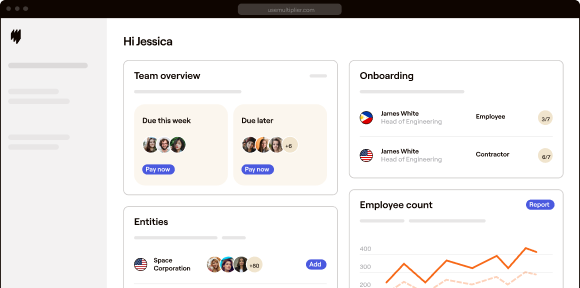Hiring in a new country is all well and good — until payroll lands on your desk. Suddenly you’re juggling unfamiliar tax codes, currency conversions, and filing calendars that don’t line up with your expectations.
This guide is here to help. From defining a payroll implementation project plan and weighing outsourcing routes to mapping each step of a global rollout — and the pitfalls to dodge — we’ll show you how the right global payroll partner turns a daunting project into a catalyst for growth.
Whether you’re upgrading legacy software, switching local vendors, or scaling for the first time overseas, here’s everything you need to know about payroll implementation to pay your people accurately, on time, and compliantly in every market you enter.
As we go, we’ll hear from experts including Michael Nierstedt, Payroll Product Director, Multiplier, and Ian Giles, Global Payroll & People Leader.
What is payroll implementation?
First, let’s define our terms. Payroll implementation refers to the project of configuring people, data, and processes so that a new payroll solution can begin running regular pay cycles accurately and on schedule. It covers everything from importing employee and contractor records, mapping earnings and deductions, setting up statutory calculations, to defining approval workflows and payroll calendars.
Global payroll implementation applies the same playbook — but on an international scale. Now you must load multi‑currency pay elements, align pay schedules across time zones, and, most critically, incorporate every country’s labor codes, social‑security rules, and tax‑filing deadlines. The goal is to create one repeatable, automated process that can run compliant payroll in every market where you employ people.
If it sounds daunting, don’t worry — there are numerous outsourcing options on the table. Here’s how each approach stacks up
Outsourcing route | Scope |
Payroll software | You license cloud payroll software and keep payroll operations in‑house |
Managed payroll vendor | You hand over processing to a domestic or regional payroll provider |
All‑in‑one global payroll platform | One platform combines compliance, payroll, and contractor/legal infrastructure, across every region you hire from |
The importance of payroll implementation
Rolling out a well‑planned global payroll implementation plan is more than an administrative milestone — it is a recipe for growth that delivers four high‑impact benefits:
- Accelerated market expansion: A compliant payroll engine lets you hire in new countries the moment business needs arise — whether that’s opening a sales office in Singapore or spinning up an R&D pod in Poland. Local talent provides on‑the‑ground insight and speeds time‑to‑revenue without the delays of entity setup.
- Stronger, more diverse teams: Global hiring injects fresh perspectives, language skills, and cultural fluency into your organisation. Diverse teams have been shown to outperform homogenous groups on innovation and problem‑solving, while also insulating the company against domestic talent shortages.
- Cost‑efficient resourcing: Accessing talent in lower‑cost labour markets can trim total payroll spend without sacrificing quality. Paying employees in their local currency, at competitive local rates, frees budget for additional headcount or product investment.
- Around‑the‑clock productivity: Distributed teams hand projects off across time zones, effectively turning an eight‑hour working day into a 24‑hour development, support, or sales cycle. Deadlines shrink and customer issues get resolved sooner.
These advantages only materialise when payroll implementation is executed correctly, however — solving every local tax headache, labour‑law nuance, and payment workflow from day one. Done right, payroll becomes an enabler, not a bottleneck, for global growth.
Step-by-step guide to global payroll implementation
Implementing — or re‑implementing — payroll at a global level is a multi‑month project that blends compliance, data, and change‑management workstreams. Below is a streamlined roadmap that works whether you are:
- Replacing your local payroll vendor
- Upgrading existing software
- Moving first‑time into a unified global payroll platform
1. The planning phase
Start by defining the outcomes you want: streamlined processes, better reporting, global compliance, or cost efficiency.
- Set clear goals: Identify what success looks like for your organization.
- Assemble a cross-functional team: Include HR, finance, IT, legal, and regional stakeholders.
- Evaluate and choose your solution: Consider scalability, in-country support, ease of integration, and your global footprint.
- Build your project plan: Include timelines, key milestones, roles and responsibilities, and a budget for implementation and maintenance.
2. Data collection and configuration
Clean, accurate data is the backbone of a successful implementation, but it requires careful gathering. As Giles says: “Stop what you’re doing, take stock of where you are, simplify and standardize wherever possible, create global frameworks for payroll, reporting and auditing while allowing for regional customizations.”
- Audit and clean employee data: Gather personal details, job info, pay rates, tax IDs, and banking details.
- Define pay elements: Standardize salaries, bonuses, allowances, deductions, and local tax components.
- Configure the platform: Customize workflows, approvals, and country-specific compliance rules.
- Integrate with core systems: Sync payroll with your HRIS, time tracking, and accounting tools for smooth data flow.
3. Test, test, and test again
Validation and education reduce errors and increase adoption.
- Run parallel tests: Compare new calculations with historical payroll runs to identify mismatches.
- Train your teams: Ensure HR, finance, and local managers know how to use the system effectively.
- Conduct a pilot: Roll out payroll for a limited group or region to catch any last-minute bugs.
4. Ongoing support
Launch smoothly — and set up for long-term success.
- Process your first full payroll run: Monitor output closely for accuracy.
- Troubleshoot issues in real-time: Set up escalation paths and support contacts.
- Offer continued support and training: Keep users informed as features evolve or regulations change.
- Refine and optimize: Review system performance regularly and adjust processes based on feedback and compliance updates.
Why lean toward a global payroll platform?
- Single contract, single SLA: Replaces a patchwork of local agreements.
- Pre‑built compliance engines: Automatic updates for tax, social security, and statutory reports in 150 + countries.
- Unified data layer: Real‑time global payroll analytics instead of stitching spreadsheets.
- Faster expansions: Expand to new countries effortlessly.
By implementing a new payroll system, you lower long‑term run costs, gain visibility, and future‑proof payroll for the next wave of markets you enter.
What does your team need for global payroll implementation?
Even on a modern platform, global payroll is a cross‑functional endeavor. To land the rollout and keep it compliant, equip your team in two critical capability areas:
- Communication and collaboration: Global payroll implementation is a process that involves multiple people, possibly in different locations. It requires efficient communication and collaboration right from the top-level HR executives to accounting teams. Having regular meetings, discussing challenges, and coming up with effective solutions are crucial for a seamless process. All the people involved in global payroll must stay aligned with deadlines and goals and collectively work to meet them.
- Change management: We know that global payroll consists of a lot of small details which must be constantly monitored. These details are bound to change whenever a country updates its labor codes and tax regulations. Staying updated with these changes and implementing them as soon as possible is the key to ensuring legal compliance. To ensure that your team is ready to take on any challenges, employers must provide the right training and support and work on streamlining the process.
Now that you know what your team needs for global payroll implementation, let’s understand the common mistakes businesses make while paying their international employees.
Common global payroll implementation mistakes and how to avoid them
People, businesses, or both, are bound to make some mistakes when trying something they’ve never done before. Here are some common mistakes businesses make when setting up a global payroll system.
- Not planning enough: Global payroll is an intricate task, and it requires a lot of planning and mapping. Before implementing a global payroll system, an employer must have a detailed roadmap of how the process will work and who will be involved. Setting goals and timelines for each step is one of the best ways to ensure nothing is missed. Ensure your team is well trained on the process, and each member is aware of their responsibilities.
- Inaccurate data: Data is the backbone of any digital project, and it is the same for a global payroll system. You must ensure that your systems are fed with the right data before you process payments to your global teams. Data fields such as employee name, title, role, compensation, bank account details, country, etc. are crucial for any global payroll team. However, the most important piece of data for a global payroll project is the deductions. Ensuring you have made the right deductions in your employee’s salary is the first step to maintaining legal compliance.
- Unconfigured systems: Integrating your global payroll with an automated system is the best way of handling payroll. However, every software has a different UI and follows a different algorithm. As an employer, you simply cannot rely on a basic dashboard to keep an eye on the process. You must configure the system and align it with your requirements. Ensure that the details you need to monitor are constantly displayed on your screen, and you don’t need to go deep into the system to fetch crucial data. All of this must be discussed and settled before choosing your HRIS partner.
- Failing to test: Running tests and finding gaps across the payroll process is the best way to identify inconsistencies in your system. Many times, companies fail to run sufficient tests, and it results in errors and delays. Testing will help you identify missing data, clarify the turnaround time, and help you understand how you can make the process more efficient. Understanding the workings of your payroll system implementation is crucial for times when you need to revamp data, include new flyers, or introduce a new feature. Testing must never be a one-time event. Even after it is live, it should be tested regularly to gauge the system’s capabilities and enhance them.
Global payroll may seem overwhelming at first, but it also brings along some significant advantages to your business — provided you choose the right partner.
Choosing the right global payroll partner
With the right global payroll partner, your implementation headaches disappear. Making the right choice requires careful consideration. “Where I usually see people get tripped up is implementation times,” says Nierstedt. “Does it calculate what I need it to? Does it make tax payments I expect? Is it going to support paying employees in your necessary locations?”
Here’s the other factors you should watch out for:
What to check | Why it makes implementation painless | Quick vetting tips |
Industry review and feedback | A partner already serving companies like yours gives confidence that they can thrive in the role.. | Ask for same‑industry references and the average go‑live time they achieved. |
Breadth of in‑house services | Different global payroll service providers offer different services. Check if your potential payroll partner can assist you with all your needs. | Evaluate your requirements and understand the specific features and services that you will need to expand your business overseas. |
Evaluate their compliance strategy | Compliance is one of the key aspects of global hiring — a company that isn’t reputable will cause you major problems down the line. | While most global payroll service providers ensure compliance, you must carefully study and evaluate their strategies for dealing with compliance issues. |
Choose a partner that scores high on these factors, and implementation shifts from a high‑risk slog to a low‑stress launch — so you can focus on scaling, not sweating the small stuff.
FAQs
Q. How can companies effectively plan and prepare for global payroll implementation?
To ensure successful global payroll implementation, companies should conduct thorough research on local labor laws, tax regulations, and payment methods in target countries. Collaborate with experts, utilize global payroll software, and establish clear communication channels. Customize payroll processes to each country’s requirements while maintaining data security and compliance. Regularly review and adapt strategies for seamless international payroll management.
Q. What factors should businesses consider when selecting the right payroll software for global implementation?
When choosing global payroll software, businesses must assess its multi-country capabilities, compliance with local tax and labor laws, integration with existing systems, scalability, data security, and user-friendliness. Compatibility with various currencies, languages, and payment methods is crucial. Prioritize software that offers centralized control, reporting, and analytics, streamlining payroll processes across diverse locations while ensuring data accuracy and legal adherence.
Q. How can companies measure the success of their global payroll implementation?
Companies can measure the success of global payroll implementation through key performance indicators (KPIs) like payroll accuracy, timeliness, compliance rates, and cost-effectiveness. Employee satisfaction, reduced manual errors, and improved data visibility are also indicators. Regular audits, feedback loops, and benchmarking against industry standards help gauge effectiveness. Additionally, analyzing process efficiency, reduction in payroll-related queries, and alignment with overall business goals demonstrate the implementation’s success in optimizing global payroll management.
Q. How long does payroll implementation take?
With a mature global payroll partner, most mid‑sized companies move from kickoff to first live pay run within three months. However, this timeframe can vary significantly based on factors like business size, complexity of payroll processes, and the choice of payroll software. Smaller businesses may be able to transition within a month; larger enterprises up to six months or more.
Q. What documents do I need to provide for payroll implementation?
Expect to supply a consolidated employee data file (personal details, contract type, compensation elements), entity registration certificates, local tax and social‑security IDs, banking instructions, historical payroll reports for at least the last two cycles, and copies of benefit policies or collective agreements. Having these ready up front lets the provider configure statutory settings, validate opening balances, and run parallel tests without re‑work.







